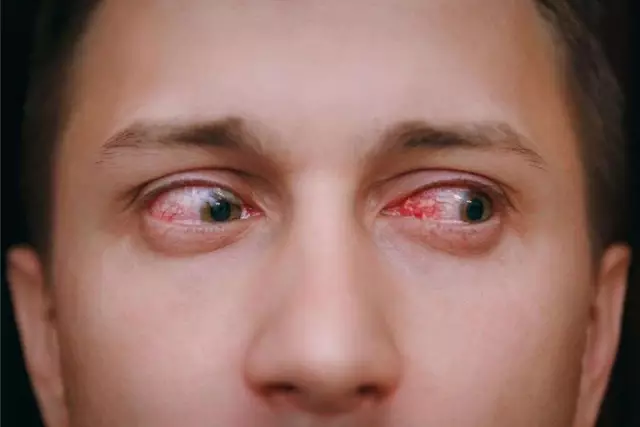- Author Rachel Wainwright [email protected].
- Public 2023-12-15 07:39.
- Last modified 2025-11-02 20:14.
Spondylitis

Spondylitis unites a group of chronic diseases of the spine and joints of inflammatory etiology, causing a decrease in bone density and severe bone deformities. In most cases, spondylitis is the result of a tuberculous infection, but there are also diseases caused by osteomyelitis, syphilis, and other primary inflammatory foci in the body.
Types of spondylitis
Ankylosing spondylitis (also called ankylosing spondylitis) is a chronic systemic disease of the joints and the spinal column. This type of spondylitis occurs against the background of constantly recurring inflammatory phenomena in the joints and spine. It is not uncommon for ankylosing spondylitis to cause complete immobility of the spine.
The disease received its name in honor of the famous physician V. M. Bekhterev, who first described in detail ankylosing spondylitis in 1892. Ankylosing spondylitis usually affects men in the age group over twenty. The disease also occurs at a younger age. Cases of ankylosing spondylitis are also recorded in women, but much less frequently than in men.
The first symptoms of this type of spondylitis include pain in the sacral and lumbar spine. Often the pain radiates to the groin area, alternately to the left or right thigh. The pain syndrome increases significantly when performing hard physical work, as well as after a long stay in a motionless state. That is why spondylitis often causes insomnia, since the increasing pain makes the patient wake up in the second half of the night. Further development of the disease, which can last for several years, is accompanied by the following symptoms:
- a feeling of stiffness and loss of mobility of the spine;
- limited (sparing) movement of the patient when sneezing, coughing, deep breath;
- shortening of the spinal column;
- the formation of the so-called supplicant's pose, which is formed due to the arcuate deformed spine.
Tuberculous spondylitis is the most common type of disease.
In tuberculous spondylitis, the characteristic focus of the inflammatory process is the thoracic spine. Other parts of the spinal column can also be affected by the disease, but such cases are relatively rare in medical practice.
Symptoms of tuberculous spondylitis include the occurrence of a destructive focus directly in the tissue of the vertebral joint, and the inflammatory process can begin in more than six vertebrae simultaneously. Further development of tuberculous spondylitis is characterized by the spread of inflammation beyond the spine. In the soft tissues surrounding the vertebrae, the so-called congestions form - cold purulent abscesses. Ultimately, the vertebrae are deformed and begin to take a wedge-shaped shape. This destructive process is often accompanied by severe and painful complications - compression fractures of the spine. Purulent abscesses of the posterior spine can cause spinal disorders, since the spinal cord is compressed and persistent edema forms.
With the development of the tuberculous form of spondylitis, three stages are distinguished:
- prespondylitic (the beginning of the formation of a focus of the disease in the vertebral body);
- spondylytic (the period of disease progress);
- post-spondylitis (the period of the inflammatory process subsiding and the formation of a severe complication - the formation of fistulas).
Spondylitis treatment

The modern medical approach to the treatment of all types of spondylitis (ankylosing, reactive, aseptic spondylitis, etc.) involves a combination of complex measures, including the following:
1. The use of drugs. For the treatment of spondylitis, anti-inflammatory nonsteroidal drugs are used, the main action of which is aimed at reducing the feeling of stiffness of the spinal column and relieving pain. Unfortunately, most of these drugs have a whole list of contraindications and side effects, one of which is severe disruption of the gastrointestinal tract. If the effect of treating spondylitis with these drugs is absent, the basic drugs used in the treatment of arthritis are prescribed - corticosteroids, methotrexate.
2. Physical therapy exercises. Experts refer to regular health-improving physical exercises as the main treatment for spondylitis. A feasible, and most importantly, correctly selected, physical load on the spinal column affected by spondylitis allows not only to maintain its flexibility and mobility, but also to correct the impaired posture, to avoid possible serious complications.
3. Thermotherapy (warming up). Warming up spondylitis-affected joints and muscle tissue effectively reduces the feeling of pain and stiffness. The use of hot baths causes reflex relaxation of the muscles, which, without the use of anesthetic drugs, successfully helps to relieve pain.
4. For the treatment of spondylitis in a particularly severe stage, they resort to surgery.
YouTube video related to the article:
The information is generalized and provided for informational purposes only. At the first sign of illness, see your doctor. Self-medication is hazardous to health!






